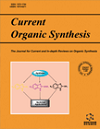-
oa Synthesis of Novel Derivatives of 4,6-Diarylpyrimidines and Dihydro-Pyrimidin-4-one and In Silico Screening of Their Anticancer Activity
- Source: Current Organic Synthesis, Volume 22, Issue 4, May 2025, p. 556 - 567
-
- 10 Sep 2024
- 11 Oct 2024
- 05 Dec 2024
- Previous Article
- Table of Contents
- Next Article
Abstract
Derivatives of pyrimidinone, dihydropyrimidinone, and 2,4-diaryl-substituted pyrimidines were synthesized by cyclocondensation of α-aminoamidines with various saturated carbonyl derivatives and their analogs. The therapeutic potential of the newly synthesized derivatives for cancer treatment was evaluated using molecular docking calculations. The molecular docking results indicate that some of the synthesized diaryl derivatives of pyrimidine exhibit high binding affinity towards PIK3γ.
4,6-Diaryl-substituted pyrimidines have shown high inhibitory potency against phosphoinositide 3-kinases (PI3Ks), which are important targets in oncology. Inhibition of PI3Ks could potentially be a viable therapy for human cancers.
The synthesis of pyrimidinone and dihydropyrimidinone derivatives as well as a series of 2,4-diaryl-substituted pyrimidines were described. These compounds were synthesized by cyclocondensation of α-aminoamidines with various saturated carbonyl derivatives and their analogs.
Derivatives of pyrimidinone, dihydropyrimidinone, and 2,4-diaryl-substituted pyrimidines were synthesized by combining α-aminoamidines with various saturated carbonyl derivatives and their analogs. By adjusting the large substituents in the 2-position, we gained the ability to modify the therapeutic properties of the resulting compounds. The potential of the newly synthesized derivatives for cancer treatment was assessed using molecular docking calculations. The results of the docking calculations suggest that some of the synthesized diaryl derivatives of pyrimidine have a strong binding affinity towards PIK3γ, making them promising candidates for the development of new anticancer medications.
We synthesized some pyrimidinones, dihydropyrimidinones, and 2,4-diaryl-substituted pyrimidines by combining α-aminoamidines with various saturated carbonyl derivatives and similar compounds. Molecular docking results suggest that certain diaryl derivatives of pyrimidine have a strong binding affinity for PIK3γ. Moreover, diphenyl derivatives of pyrimidine exhibited dual inhibitory activity against PI3K and tubulin, showing promise for the development of next-generation microtubule-targeting agents for use in combination therapies.


